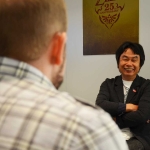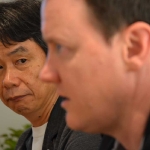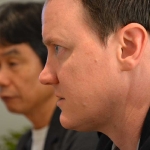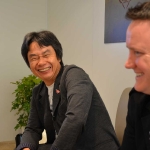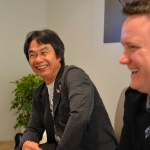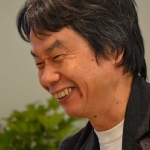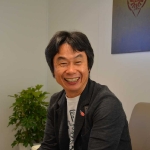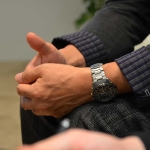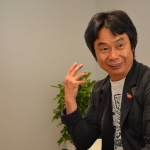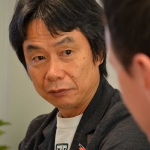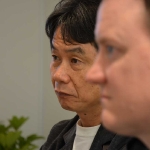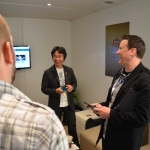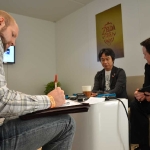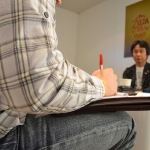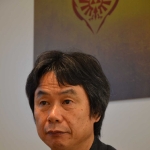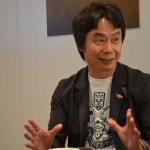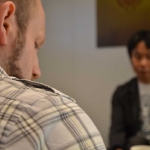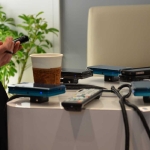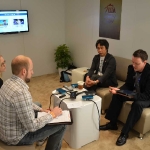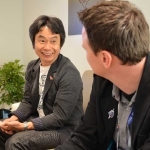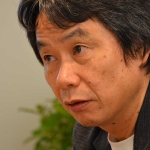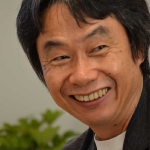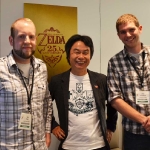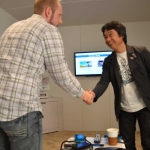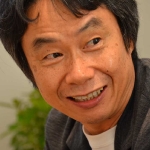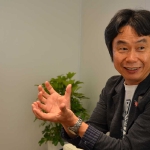Miyamoto interview: Wii U, rejected ideas, Zelda concerts, Four Swords DSi, Skyward Sword, and tons more
Posted on June 17, 2011 by Brian(@NE_Brian) in 3DS, DS, News, Wii, Wii U
To make that title less than 500 words, I had to make it a bit more vague than I had wanted. But I highly suggest reading the interview that Game Informer conducted with Shigeru Miyamoto below, since there’s a significant amount of information. Miyamoto discusses topics including the Wii U, why the time is right for Zelda concerts and Four Swords on DSiWare, some initial concerns about Skyward Sword and how it’s a “very open world”, and a whole lot more.
Miyamoto on why the time is right for an HD Nintendo console…
“It was something we were considering even when we were first working on the original Wii. For a variety of reasons at the time we opted not to include the HD functionality. In the years since we’ve seen the penetration rate of HD increase much more rapidly than we had anticipated. Probably because some of the TV manufacturers thought they could sell TVs without needing to make a profit. We’ve seen the increase in HD TVs be very dramatic, so we felt this time is was important for us to include HD functionality in the system.”
Miyamoto on why Nintendo is now choosing to make the highlight of its console a controller with a screen built in…
“We’ve tried connectivity in the past, and we have a lot of different game ideas based on the experiments that we’ve done before. Even looking at the connectivity that we did back then — even if all you needed was a single cable to connect — you’d have people who had that cable, but you’d have people who didn’t have it. Of course, we were looking at connectivity in the sense of having a home console and then a portable, and having to have both of those. What that ends up doing is limiting the audience that you’re able to reach with the content that you’re providing because you have to own both and not everybody would.
“So really what we were looking at this time was more how can we create this stable environment both for Nintendo itself and for third-party developers so that there’s one target environment that they’re developing for that allows them to create an experience that leverages the full capacity of that environment without having to worry about whether or not everybody has everything they need in order to enjoy that experience. So that’s why when you look at Wii U we’re offering that as a set structure where you have the new controller with the screen, you have the console, and everybody who buys the console is going to have that. It makes it easier for development teams to ensure that they’re creating content that everyone can enjoy.”
Miyamoto on whether Nintendo will set a standard that requires all games on the Wii U to use the controller’s screen functionality…
“We’re not going to set any requirements in terms of how developers have to adapt the functionality of the controller to their games. I think what we saw most with Wii was that because the number of buttons on the controller was somewhat limited compared to what developers were used to developing for, that they felt that they needed to implement motion controls to allow for the variety of gameplay and the variety of actions that they would normally want. This time, if you take a look at the Wii U controller, what you’ll see is, yes, it does have motion control and it does have a touch screen, but it also has a full complement of buttons to go alongside that. So it’s really going to be up to the development teams to decide if they want to take advantage of button control, motion control, the touch screen, and they’ll be able to leverage their own creativity and find the gameplay style that’s going to be best suited to the games they’re developing.”
Miyamoto on whether he still ever has ideas that are sent back to the drawing board…
“Yes, that’s pretty common, actually. Part of the development research process is running different experiments and looking at them and trying to decide which ones are strong enough to be turned into retail products. The ones that aren’t are shelved and we may come back to them later and look at ways to bring them to life. It’s not just limited to art styles, but entire gameplay structures and gameplay systems.
“Skyward Sword is another good example of that. That’s a game where we started the experiment based on the Twilight Princess game that really focused in on what the new gameplay styles are going to be, and those new interactions that we’re going to focus on in this game. We worked on a number of those and figured out which are the ones that we’re going to bring to life in a new game. In that process the games evolved. It wasn’t until we got to the point where we were able to evaluate those and really make a final decision. I was a little nervous about the game early on, but now it’s come along quite nicely.”
Miyamoto on whether there are plans to offer those popular, smaller types of games via the Wii U…
“Unfortunately, I don’t have an iPad or an iPhone myself. But at work I am often checking out what’s going on on those platforms.
“Essentially when Nintendo is looking at creating games we’re really looking at it from that final quality standpoint and what that entertainment experience is. I think where one of the challenges lies is now sometimes we’ll look at a system and try to figure out the best game that we can create within that interface. Sometimes we may have an idea that we want to bring to life and we may build a piece of hardware around it that allows us to turn that idea into a true entertainment experience. I think where the challenge then lies is in terms of looking at games that have appeared on other platforms, finding any that when you bring them to a new platform, or to our platform, are there ways that the new platform can make them more intuitive or bring a new element of fun to them that can make them more unique? If there were examples of that then we would have no qualms about bringing them to the platform. That would be regardless of whether they where deeper experiences or even the more simple, intuitive, but very short experiences that you mentioned.
“What I think is very appealing about Wii U is that you have this controller, and I guess to some people’s eyes it looks somewhat like a tablet, but really it’s not about just what that experience is with that individual controller, but really it’s about how you interact with that controller and the TV together, and the dynamic that can occur between those two devices that I think opens up a lot of possibilities.”
Miyamoto on whether there were plans for Wii U to be its own self-contained system that you could take with you…
“That’s a tough question. I guess what I should do is explain where the idea started from. The concept for Wii U came from, ‘where do we want to take the future of home console gaming?’ Particularly with the thinking that the home console is something that’s connected to the TV, we started to think about how we can leverage the TV and interact with it in different ways and use that to change the living room entertainment experience. What we didn’t do is look at in terms of how can we connect a portable gaming device to a console.
“One of the challenges with the home console is that up until now for the home console to function is it has to be connected to the TV. Particularly now when turning on the TV doesn’t instantly bring up an image, it takes time for the picture to come up, or someone else is using the TV, that then creates barriers for people to use the home console. What we thought was what can we do to make this device that anyone can access instantly at any time regardless of what’s happening on the TV? How can they use this controller to very quickly turn on the system, see what’s new there, see what their friends have been playing, and have instant access to that. What we decided is that in addition to the TV screen that the console is going to use, we needed an additional screen that is quick, easy access to everything that the system has to offer.”
Miyamoto on putting more focus on the Wii U controller rather than the console…
“In terms of what we’re going to be doing is we’re going to be releasing Wii U, it’s a new console. The consumers will ultimately be buying a new console. In terms of what they’re going to be experiencing, it’s less about the console itself and it’s more about the experience you have with that controller and your interaction with the TV. In terms of trying to convey the concept of what the console is capable of, showing the console itself wasn’t important at this point in time.”
Miyamoto on whether he decided to hold off on the Zelda concerts in order to coincide with the anniversary…
“We were never at point early on in thinking we want to do a concert but let’s just wait until the 25th anniversary. Really what happened is Nintendo is a video game company, and we don’t put on concerts and we don’t really expand beyond the video game realm. But when we started thinking about the 25th anniversary and what we could do to let the fans appreciate and celebrate that, one thing we looked at is the connection the Zelda series has to music. In recent years as we’ve moved towards orchestrated music, and the music has taken on even greater importance in that sense, we felt that the idea of holding a concert to celebrate the 25th anniversary was something that meshed really well and made a lot of sense.”
Miyamoto on whether he is happy with what the Zelda series has become…
“The thing that we think is valued the most in the Zelda series is that the player isn’t just playing a game. The player is in that world and part of that adventure and using their own abilities to solve the puzzles and fight the enemies that are there. I think that’s really where we’ve put our focus on that series over the years. Possibly as a result of that there’s the tendency for the gameplay to feel a little bit more linear. Really what’s important for us is that satisfaction that you get from sitting down and thinking your way through those puzzles and finally solve them.
“So the idea is that the player grows and matures over the course of the adventure, and one way to strengthen that feeling for the player is to have the adventure follow along with a flow and be very connected to a story that progresses as the play progresses through it. I think that’s where the structure or the order of the game comes from.
“Of course, as the games evolved into the full 3D worlds, and more recently with the implementation of motion control, I think that sense that you’re the one in that adventure experiencing it has strengthened greatly. I think in that sense the Zelda series has really evolved.
“The other thing that we did with the Zelda series is we intend to create the game in way that the player has a tremendous amount of freedom in terms of the things that they’re able to do. As they explore the world and discover things and try to play the game in different ways, there are little thing sprinkled throughout the world that will reward them for that. I do think that the notion of following a story perhaps pushes people towards that normal progression of the game. What I’ll say about Skyward Sword is that there’s a tremendous amount of places you can go and things you can do in that game. It’s very open world, and I would encourage everyone to go and explore every nook and cranny of that game as well.”
Miyamoto on why Nintendo is giving away Four Swords on DSiWare…
“I think Four Swords is a very fun game… Obviously, because you needed so many Gameboy Advance link cables to play the game when we released it on Gameboy Advance, not many people played the game. So from my perspective it’s very fun and I want many people to play it as well. But our sales team is worried that it’s a tough thing to sell. Now with the Nintendo 3DS and the more recent systems, the communication and multiplayer doesn’t require a cable anymore – it can be wireless. For many years we’ve been talking about how we wanted to take advantage of that and remake Four Swords. Particularly this year, being the 25th anniversary of Zelda, we wanted to offer people something that would allow them to play Zelda together very quickly. So we decided to take the original and make it available for people to play via their DSi. Bill [Trinen, Miyamoto’s translator] was also asking us to make Four Swords Adventures and Tetra’s Trackers for Wii.”
Miyamoto on why Nintendo didn’t promote the new Kirby games at their conference…
“We really streamlined the conference this year to focus on a few things, being the Zelda 25th anniversary, the 3DS, and the Wii U. The Kirby games didn’t fall into any of those big buckets. Also, in terms of E3 being an industry show and a business show, we look at the presentation as being one way of being able to talk about our products. Particularly with the two Kirby games you speak of, we still feel there are a lot of ways we can deliver the message of those games to consumers.”
Miyamoto on whether rivalries like the ones that have existed between Nintendo development teams in the past are still in place to spur on creativity…
“It’s not something that people are consciously thinking of internally. Even in the past I don’t know that it was a very competitive environment. If you have one team of people that works together all the time, then gradually they’re going to drift into a particular area of development or continually focus on the same types of things. So I do think it’s important to have different groups set up with different individuals in those groups who are responsible for doing the creative thinking and ensuring that each of the different teams are continuing to maintain their creativity.”
Miyamoto on how Super Mario 3D is somewhat like Super Mario Bros. 3…
“It’s true that from a design standpoint the development team has drawn a lot from Super Mario 3, but the overall intention is not to focus just on Super Mario Bros. 3, but really to look at what we’ve done in the Mario franchise overall and look at how we can evolve the Mario gameplay in new ways in order to create this new 3D Super Mario Bros. I think that you’ll find it becomes sort of a Mario 64-esque Super Mario World type of game.”
Miyamoto on why he thinks fans seem to love the Tanooki suit above all Mario power-ups…
“This is maybe not necessarily related to why it’s so popular, but a couple things about the Tanooki suit is when first worked on it we had a lot of freedom and came up with this whimsical suit that Mario could use. In Japan there are a lot of folktales about the Tanooki, which is an actual animal in Japan. But the folktale talks about how the Tanooki can grab a leaf, hold it to its head, and transform. We had a lot of fun with that idea and bringing it into the game. From a functional standpoint what the Tanooki suit does is Mario jumps in the air and whips his tail back and forth so that he floats down very slowly. The slow floating is something that I think is very fun, but it also has very strong meaning, particularly when you’re playing in a 3D game in terms of having that ability to float down slowly and glide through the environment. Again, not related to why it’s so popular, but those are some of the elements of the Tanooki suit that I really like.”
